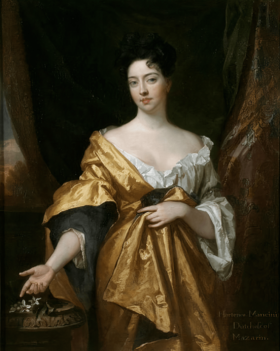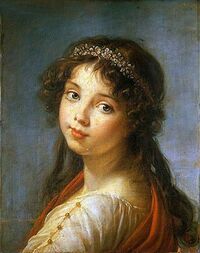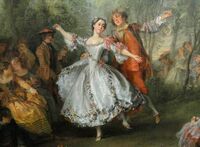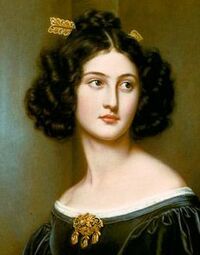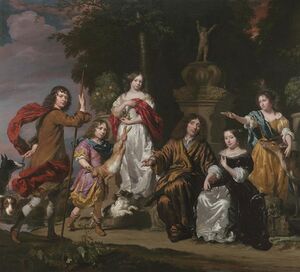Difference between revisions of "Mary Casimira of Carrington"
m (→Titles and Styles) |
m (→Marriage) |
||
| Line 80: | Line 80: | ||
Lord Viathan and Lady Mary were wed on the 16th of Sun's Smile, 1819, in a private ceremony attended only by her family and his as well as her sister's betrothed. The two received many gifts and Mary often said that was the last time she was happy. In the wedding Mary sported a gown similar to the ancestral that had been passed down on her father's side of the family though the thought of wearing a dress that had been worn by many different people in her own family drove the d'Arkent away from such, causing her to seek the help of hobby seamstress Leopoldine Vimmark-Roussard. Alongside the newly crafted gown Mary donned the tiara her mother had at her debutante, the Pruvian Tiara from the [[Princess Anna Sophia of Pruvia]]. The tiara was decorated with an array of pearls and intricate gold workings that accented and framed the girl's face as it has never been framed before. It was almost instantly after the marriage that Lord Viathan did all but die, he had simply left the city leaving the girl- as she said- to sire an heir and family all on her own. | Lord Viathan and Lady Mary were wed on the 16th of Sun's Smile, 1819, in a private ceremony attended only by her family and his as well as her sister's betrothed. The two received many gifts and Mary often said that was the last time she was happy. In the wedding Mary sported a gown similar to the ancestral that had been passed down on her father's side of the family though the thought of wearing a dress that had been worn by many different people in her own family drove the d'Arkent away from such, causing her to seek the help of hobby seamstress Leopoldine Vimmark-Roussard. Alongside the newly crafted gown Mary donned the tiara her mother had at her debutante, the Pruvian Tiara from the [[Princess Anna Sophia of Pruvia]]. The tiara was decorated with an array of pearls and intricate gold workings that accented and framed the girl's face as it has never been framed before. It was almost instantly after the marriage that Lord Viathan did all but die, he had simply left the city leaving the girl- as she said- to sire an heir and family all on her own. | ||
| − | [[File:maryxviathanwedding.jpg |thumb|left| | + | [[File:maryxviathanwedding.jpg |thumb|left|300px|''"A post-wedding soiree" (Circa 1819), by Claire Marie Elmpool. The portrait depicts the newly-wedded couple alongside their close family and friends after their wedding.'']] |
====After the Marriage and Pregnancy==== | ====After the Marriage and Pregnancy==== | ||
Revision as of 02:19, 30 July 2021
|
| ||||||||||
Mary Casimira, of the House Carrington was the firstborn daughter of Charles, Baron of Carrington, only son of Mary Lucille and Joseph John of Selm. Her life was filled with palatial escapades, courtly etiquette, and Imperial Fashion.
Contents
Early Life
Mary Casimira d'Arkent was born 17th Sun’s Smile, 1801 at Trissingham Court to Charles Augutus, the 3rd Baron of Carrington and his wife, Anna Henrietta of Provins. Upholding the tradition within the Carrington line Mary was named after both of her grandparents, the late Baroness, Mary Lucille and Viscountess-Dowager Casimira Philippa of Pompourelia.
At her birth Mary's father was in the prime of his tenure as Governor of the Palace resulting in a palatial upbringing with court tutors and palace servants at every turn. The girl swiftly took notice of the inner-workings of the court and the many facets of Imperial Court and it's courtiers. Following the disappearance and presumed death of her father, Mary's mother took his place as the first Governess of the Augustine soon lofting her daughter take the role of Majordomo of the Augustine at the age of fourteen.
In her youth Mary enjoyed many different activities at the Augustine, the first of which being the Providence Scouts led by Emerentia Kovachev, though the d'Arkent swiftly stopped all participation after an excursion to the bastian was far too "Boyish" for the prissy, petite d'Arkent. Mary found her groove within the courts, however, finding much more enjoyment working alongside her mother rather than even other children. The girl even went as far as to aid the palace garthers in their efforts of the Imperial Garden's upkeep, often saving clippings from her favorite flowers to gift to her now dearest friend, her mother. Her close relationship with the palace's staff certainly aided her overall opinion at court, swiftly becoming a beloved member by the Imperial Family and courtiers alike.
Within her aforementioned role of Majordomo Mary soon flourished, being deemed too young to take on such a role by her worrisome mother caused a pause before she began publishing her first events and missives, however the courtiers did not wait in vain as the girl produced her first missive at the age of fifteen, an institution that is still in use today under one of the woman's collages. After her first, many others followed, the most popular of which being the Carrington Soiree of 1817 [1]. The event was popularized by a missive written by Mary's cousin, Maisie d'Arkent, that detailed everything wrong with the event from the lack of order to the missing guests of honour. Maise recieved quite a bit of backlash from the public since she made the fatal mistake of putting her own name on the gossip column.
The Social Season of 1817
Upon the year of her sixteenth birthday the second Social Season was announced [2], Mary often joked with her sister that the season was made for the two of them since they were the exact age a debutante should be. By the time the season began Mary had already began her work as Majordomo alongside her mother, the Lady Governess Dame Anna Henrietta, so eyes were on her to throw the most lavish and beautiful parties of the season, however it would seem as if the pressure grew too much for the budding woman as the season was filled with the exact opposite type of talk that she would have liked to have heard. After the initial debut and announcement of this season's ruby, Lady Elisabeth Tuvyic, the girl was spotted visibly upset however the missives posted depicted a much more dramatic image of the girl as she grew upset of the lack of title graced upon her name.
The First Match
Following shortly after the debut was scheduled a dance where the debutantes may become better acquainted with the gentlemen of their choosing. Mary had her eyes set upon a certain gentlemen since before the season had even begun, however his presence was missed at this ball in particular, instead a blonde Fitzpeter boy had seemingly caught the debutantes eye in the original suitor's place. The two were seen dancing not once, but twice the night and even speaking after the ball had finished. Throughout the season the two were seen together on many occasions although with a swift change of heart, or mind, the match was not withheld.
The Second Match
Intertwined with her match with the Fitzpeter was a second match with the Othaman heir, Lord Viathan. The two shared multiple dates and they were even seen together at an event Lord Viathan hosted after the date he had truly invited didn't care to show up. It was rumored that the match was all crafted by Mary and her mother before the season even began and all of their conversations were calculated moves made by Lady Mary leading to the proposal they had hoped for since the girl's childhood.
Career and Life at Court
Majordomo of the Augustine
In her youth the title of Majordomo was bestowed upon Mary, a title previously held by the like of Milena of Dobrov, Vespira d'Emyth, and HIH Princess Elizabeth Anne. Albeit she was too young to take on the role fully after only a year of training she began the work of her predecessors just the same. The first formal event planned by the Majordomo was a collection and feast of the nobles of the empire where she stood alongside John VIII, Holy Orenian Emperor in the absence of her mother, she worked as the stand-in Governess.
Soon after the many feasts and small teatimes held by the youthful Majordomo the, now woman, began preparations for her first large-scale event. Many missives have surfaced of letters and correspondence with the d'Arkent woman and many tradesmen and even exotic animal-tamers in perpetration for the grandiose event. Even though the girl had prepared for the event in various ways, even going as far as to have an elephant brought to her family's estate in the Orenian countryside despite it being far from its natural habitat, the event was a massive failure and certainly a stain on her event planning career. Leaving an even larger stain on her career was the flurry of gossip that soon followed. Almost as soon as the party closed hundreds, if not thousands of parchments fluttered through the palace halls detailing the failures of the girl's event written by her cousin Maisie d'Arkent.
Shortly after the failure of the soiree the girl had all but quit the job in its entirety, denouncing any event planning for the rest of her life. Although the girl had ran from any responsibilities her job had brought her she soon persevered with yet another institution, this one of Orenian Court Ladies. The Lady's Society was a group of courtly ladies that gathered every once and awhile to discuss the matters at court and even traveled to Haense to visit with their Lady's Society while they did the same. Lady Mary often jested that she strengthened the diplomatic ties betwixt the states through the power of women and consorts, for the fastest way to a state's center is through its ladies.
Mistress of the Arts
With the rise of the Countess of Renzfeld court reforms were in order, for the previous Empress-to-be had left the courts in quite a tizzy after her annulment with Emperor, John VIII. Talks of court reforms were hot on every courtier's lips throughout the Orenian Courts as the ladies planned for many changes. The Countess of Renzfeld, with the help of HIH Helena Augusta; Lady Mary Casimira; and the late Governess Dame Anna Henrietta, created a three-headed courts system set with a Mistress of Ceremonies, Mistress of the Household, and the Mistress of Arts; the role Mary had chosen to take up, having always taken a liking to the artistic side of her pervious job.
Almost as soon as the new courts were set in place the woman began the first of her works: Fashion. Fashion within Oren had always been a passion of Mary's, learning to sew from the works of her mother and great-grandmother alike, hence the reason this was the first sect of courtly culture she chose to focus on. With the aid of her court Mary produced the first of many Fashion Reforms for Orenian court [3], practically banishing the more revealing and high-waisted dresses of the past to be replaced with elongated bodices and modest garments.
The Fashion Reforms put in place by Lady Mary were well-liked among the courts, especially among the wig-sporting Imperial Family of present. Although some portions were harder for some to understand, such as dressing above ones station. It is believed that Mary struck down many that dressed above their station, never shying away from an argument with a younger imperial lady who hadn't studied the reforms prior to welcoming themselves at court. Whilst overseeing the third Social Season alongside Princess Imperial, Elizabeth Anne, Mary even went as far as to call out a girl with exposed shoulders at the lesson prior to the season and it's rumored that certain debutantes had their chances at the season's ruby lessoned due to their contrasting dresses and accessories.
Life outside of Work
wip
Marriage
The Season had served its purpose, a match had been made and was set in place by Holy Matrimony. The marriage of Lord Viathan and Lady Mary, him six years her senior, had been a plan crafted by her mother when she was only six or so. The plans for her betrothal had not only secured her a spot on the Empire's short list of consorts, but also held her higher in regards to aiding the family she had married into. Due to family's messy blodd, Mary was set to begin the fight against such and aid the family into courtly relevance, a place she had most certainly succeeded unlike the family she married into.
The two first met far before the social season at a ball held by the Princess Imperial, Elizabeth Anne. The two were spotted by the girl's mother sharing a juice box and it is said that in that moment the marriage was set. The late Dame of Provins began having many meetings with the- then Othaman Heir- Sergei, where they supposedly discussed the future of their two children, however gossip articles suggested they discussed far more than that. The stirring between their two parents drove the two apart for a while, no trace of any communication between them until the beginning of the Social Season in which they were both placed. Even in the beginning of the season the two avoided each other, and it is said that Lord Viathan even withheld his presence from a ball just because Lady Mary had been in attendance. However with a bit of hard work the two were talking once more, putting the dramatic past they shared behind them.
Lord Viathan and Lady Mary were wed on the 16th of Sun's Smile, 1819, in a private ceremony attended only by her family and his as well as her sister's betrothed. The two received many gifts and Mary often said that was the last time she was happy. In the wedding Mary sported a gown similar to the ancestral that had been passed down on her father's side of the family though the thought of wearing a dress that had been worn by many different people in her own family drove the d'Arkent away from such, causing her to seek the help of hobby seamstress Leopoldine Vimmark-Roussard. Alongside the newly crafted gown Mary donned the tiara her mother had at her debutante, the Pruvian Tiara from the Princess Anna Sophia of Pruvia. The tiara was decorated with an array of pearls and intricate gold workings that accented and framed the girl's face as it has never been framed before. It was almost instantly after the marriage that Lord Viathan did all but die, he had simply left the city leaving the girl- as she said- to sire an heir and family all on her own.
After the Marriage and Pregnancy
After only the most minimal of visits from Lord Viathan, Lady Mary was with child, however the pregnancy was quite difficult for the woman though she managed their first and only boy, Jon Nikolas Othaman. Following shortly after Jon were the girl, first Elizabeth then Irena and finally Lorina though not without their difficulties as well. Intertwined with her few successful pregnancies were two still-births, one a second son and the other a set of twins before and after their middle daughter Irena Sigismunda. Despite the many difficulties Mary had with her pregnancies she still longed for a second son, often saying she wished for a boy of her own as she felt the son she had grew to resemble his father far too much for the girl's liking.
Titles and Styles
- 1801 - present The Honourable, Miss Mary d'Arkent of Carrington
- 1816 - 1822 The Right Honorable, The Majordomo of the Augustine
- 1819-Present Lady Viathan Othaman
- 1822 - present Her Excellency, The Mistress of Arts and Culture
Issue
| Name | Birth | Death | Marriage | |
|---|---|---|---|---|
| Jon Aleksandr Othaman | 1819 | Alive | Unwed | First and only son to Mary and Viathan, Grand-Heir to the County of Valles. |
| Elizabeth Augustina Othaman | 1823 | Alive | Unwed | Firstborn daughter to Mary and Viathan. |
| Irena Sigismunda Othaman | 1825 | Alive | Unwed | Secondborn daughter to Mary and Viathan. |
| Lorina Isabel Othaman | 1828 | Alive | Unwed | Thirdborn daughter to Mary and Viathan. |

